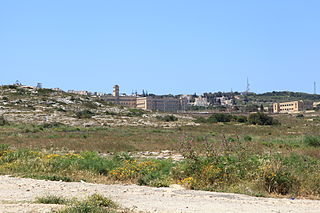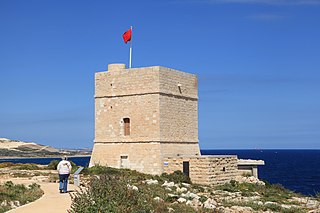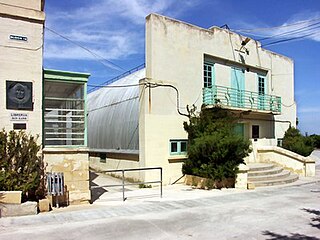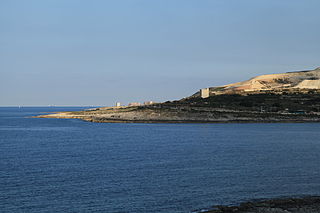
Catterick Garrison is a major garrison and military town three miles (5 km) south of Richmond, North Yorkshire, England. It is the largest British Army garrison in the world, with a population of around 13,000 in 2017 and covering over 2,400 acres. Under plans announced by the Ministry of Defence (MoD) in November 2005, the population of Catterick Garrison was expected to grow to over 25,000 by 2020, making it the largest population centre in the local area.

Qormi, also known by its title Città Pinto, is a city in the Southern Region of Malta, located southwest of Valletta in the centre of the island. It has a population of 16,324, which makes it the fifth largest locality in Malta.

Pembroke is a town in the Northern Region of Malta, and it is considered to be the country's newest town. To the east is Paceville, the nightlife district of Malta. The coastal town and tourist hub of St. Julian's lies to the southeast, and the residential area of Swieqi lies to the south. The hilltop village of Madliena is to its west, and Baħar iċ-Ċagħaq lies to the northwest.

Madliena Tower, originally known as Torre della Paulina, is a small watchtower in Madliena, limits of Pembroke, Malta. It was completed in 1658 as the fourth of the De Redin towers. The British built an artillery battery next to the tower in 1908–1909, and the tower and battery remained in use until World War II. Today, the battery no longer exists but the tower is in good condition.

The Royal Naval School was an English school that was established in Camberwell, London, in 1833 and then formally constituted by the Royal Naval College Act 1840. It was a charitable institution, established as a boarding school for the sons of officers in the Royal Navy and Royal Marines. Many of its pupils achieved prominence in military and diplomatic service. The school closed in 1910.
The Liceo M.A. Vassalli is situated in Tal-Ħandaq, Qormi (Malta) on the site of the former Royal Naval School Tal-Handaq (1947–1978). The Junior Lyceum was founded in 1981, and offers secondary education to male students aged 10 to 16. The school complex is characterized by Nissen huts and small blocks in a random layout. Having formerly been a barracks during World War II this layout intended to give the site resemblance with a Maltese village, in order to give camouflage from the air.
Tal-Ħandaq is an area in Qormi, Malta. It is a low hill. Situated on the left side of Mdina Road in Qormi, in the old days it was a rural area, with a few farms. In the 19th century, the British established a barracks up the hill. Between January 1947 and July 1978 Tal-Ħandaq was the site of the Royal Naval School Tal-Handaq. The site re-opened as a new school in September 1981 as the Liceo Vassalli Junior Lyceum.

A Royal Naval Hospital (RNH) was a hospital operated by the British Royal Navy for the care and treatment of sick and injured naval personnel. A network of these establishments were situated across the globe to suit British interests. They were part of the Royal Naval Medical Service.

The Royal Naval School Tal Handaq was a school for children of personnel of the British Armed Forces posted to Malta between January 1947 and July 1978. Formerly known as the Naval Children's School and HM Dockyard Children's School, it had occupied sites at Ta'Xbiex, Cottonera, Senglea and the Dockyard before moving to Tal Handaq, a military camp, built during World War 2, to resemble a Maltese village when viewed from the air. Staffed partially by Royal Naval personnel the school was also used by children of personnel of the Military of the United States in the 1950s. When first occupied as a school in 1947 only the buildings in the southern and central area of the present day school had been built. The remaining buildings were constructed in the early to late 1950s, initially with the objective of supporting a complement of some 800 British Forces pupils. The school was co-educational with similar numbers of boys and girls. It was also both a Secondary Grammar and a Secondary Modern school until 1963 when it re-formed as a comprehensive. Numbers at the school steadily increased until by 1960 the school held over 1000 pupils. Even so, class size was still not excessive with a typical class size of 25 pupils in 1960.

The De Redin Towers are a series of small coastal watchtowers built in Malta by the Order of Saint John between 1658 and 1659. Thirteen towers were built around the coast of mainland Malta, eight of which still survive.

Service Children's Education (SCE) is an organisation of the United Kingdom government responsible for the education of the children of British Armed Forces families and Ministry of Defence (MoD) personnel serving outside of the United Kingdom. They provide schools and educational support services from Foundation Stage through to sixth form. They are headquartered at Trenchard Lines, Upavon, Wiltshire.
Pembroke Garrison is a dispersed collection of former British Army barracks built in the vicinity of Fort Pembroke, northern Malta.
Pembroke Military Cemetery Malta is a burial ground for military personnel and their dependants. It is located close by the former St Patrick's Barracks in the Pembroke Council area, on a minor road.

The Royal Malta Artillery (RMA) was a regular artillery unit of the British Army prior to Malta's independence. It was formed in 1889, having been called the Royal Malta Fencible Artillery from 1861 until 1889.

The Malta Fortress Squadron was a locally recruited Royal Engineers unit based on Malta and on the British Army colonial list prior to Malta's independence. Its history is intimately tied to the succession of engineer and sapper units that were formed and reformed to support the extensive fortifications on the island of Malta. However a distinct Maltese Sapper force is raised in 1892 and remains until 1970.

Malta Command was an independent command of the British Army. It commanded all army units involved in the defence of Malta. Once mobilised the Command deployed its headquarters to underground hardened shelters and its combat units were deployed to fixed points in the Maltese countryside, from where they operated from. This mobilised, but largely static army garrison would be tested by aerial bombardment and naval blockade during the Second World War. Whilst Malta Command was already a functioning command structure before 1939, it had existed in the Great War and was specifically mentioned in a House of Commons debate of 12 February 1917; the Second World War would see the Command operate as a genuine war-fighting headquarters, albeit in a static defensive role.

Royal Air Force Krendi, also known as RAF Qrendi, was a Royal Air Force base located on the island of Malta, near the town of Qrendi. The station life in 1941 as a diversion airstrip for the main operating bases such as nearby RAF Luqa. Other diversion airstrips similar in function to Krendi were located at RAF Safi and on Malta's second island of Gozo. Later, in November 1942, the British began basing fighter squadrons at Krendi. These remained until late 1943. After the war, the airfield was used as a tracking station and vehicle park, before falling into disuse.

Villa St Ignatius is a historic villa located in the Balluta area of St Julian's, Malta. It was built in the early 19th century for the English merchant John Watson, and it might be the earliest example of Gothic Revival architecture in the country.
















